Abstract
We examined the biological properties of purified Escherichia coli heat-stable enterotoxin II (STII) using mouse intestinal loop assays and compared these properties with those of heat-stable enterotoxin I (STI) and cholera toxin (CT). The action of STII over time differed from those of STI and CT. STII did not alter cyclic GMP or cyclic AMP levels in intestinal mucosal cells. Our results supported the idea that the mechanism of action of STII in inducing fluid secretion is different from the mechanisms of action of STI and CT. This hypothesis was further supported by the fact that an anti-STII neutralizing serum did not neutralize the activities of STI and CT. Subsequently, we examined the involvement of prostaglandins in the action of STII. The level of prostaglandin E2 in the fluid accumulated as a result of the action of STII increased, and the prostaglandin synthesis inhibitors aspirin and indomethacin significantly reduced the response to STII. These results implicate prostaglandin E2 in the mechanism of action of STII.
Full text
PDF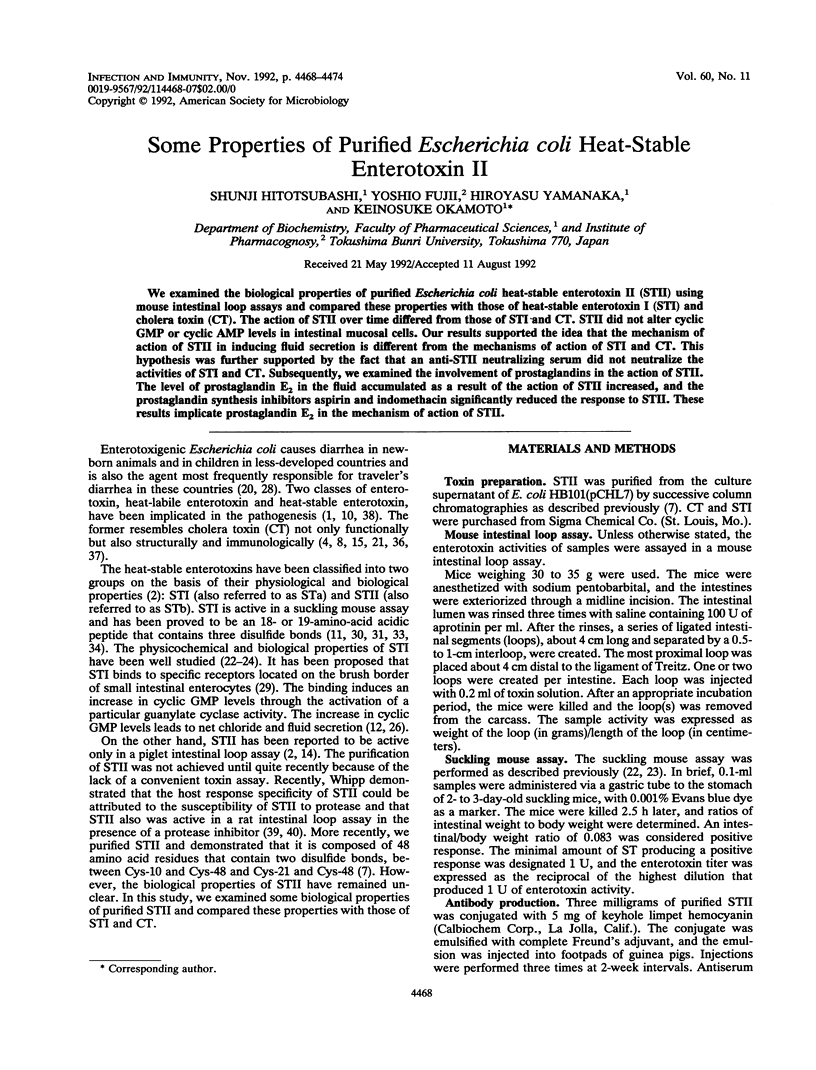
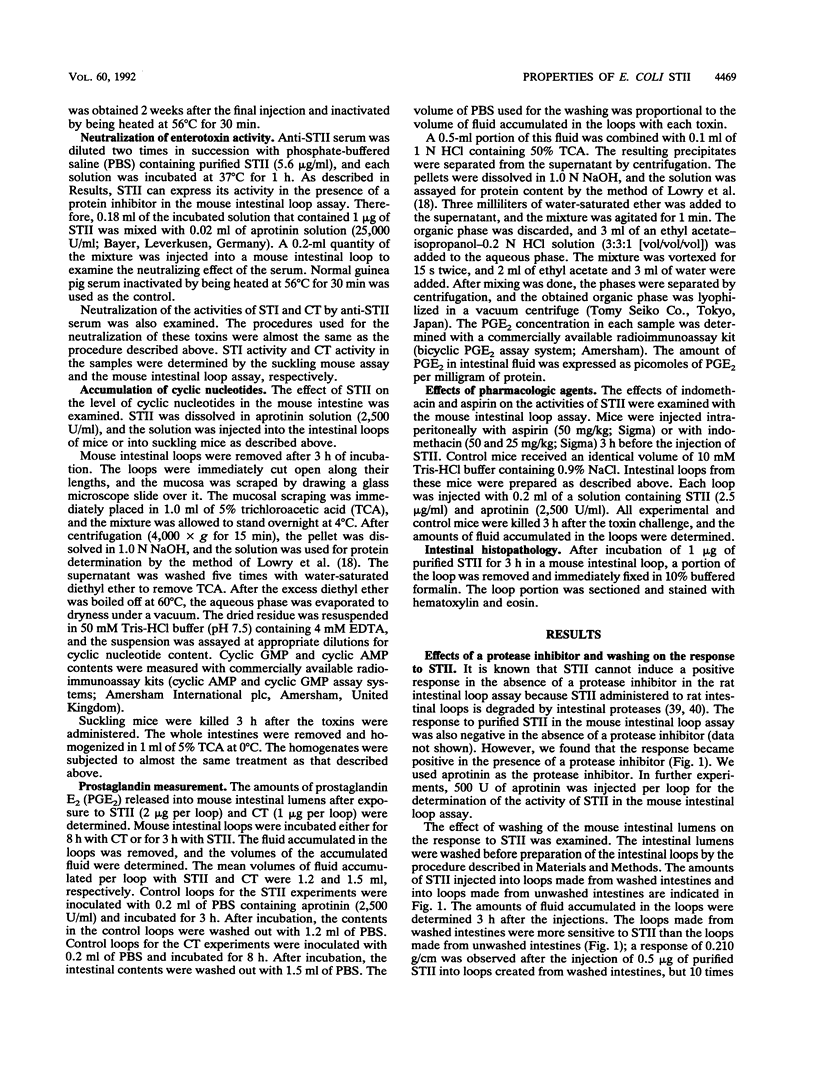
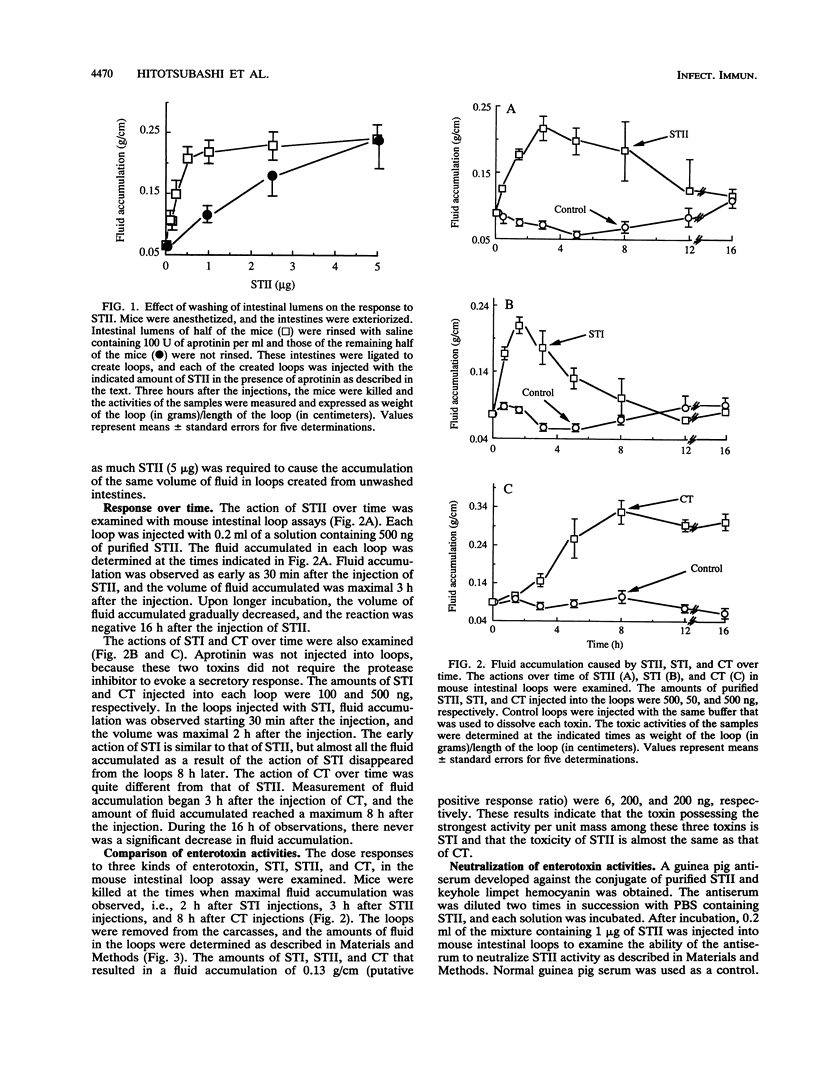
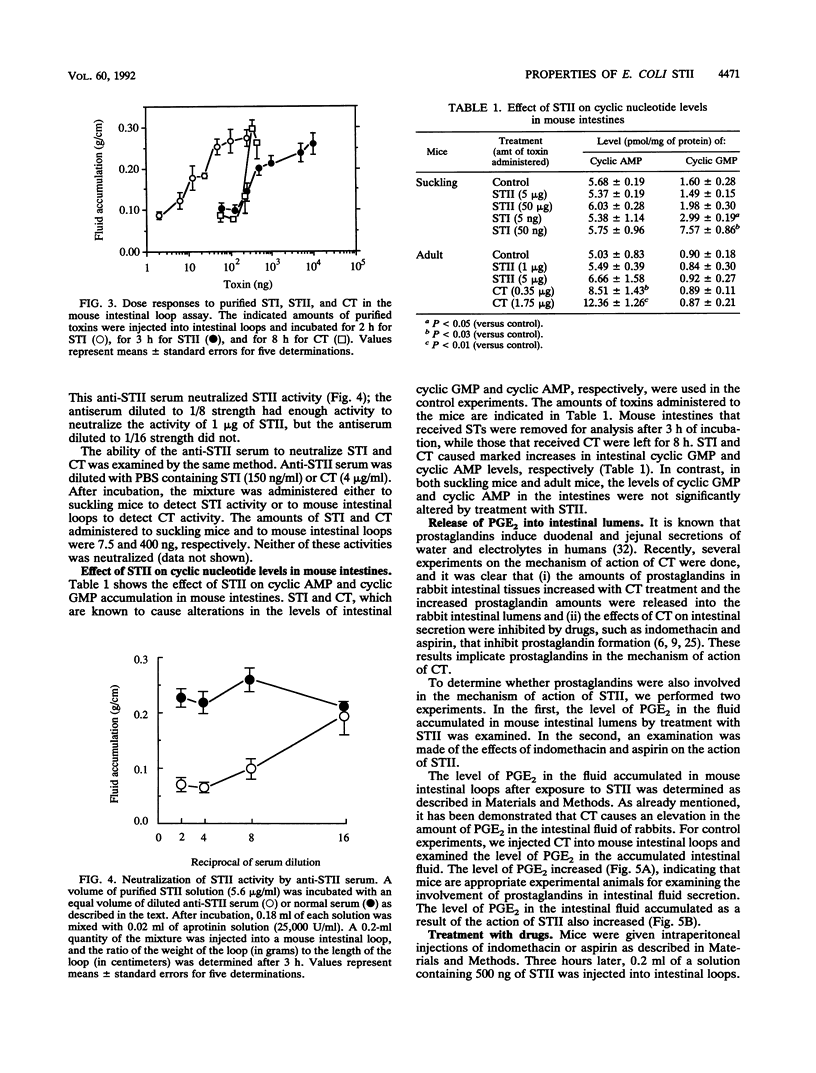
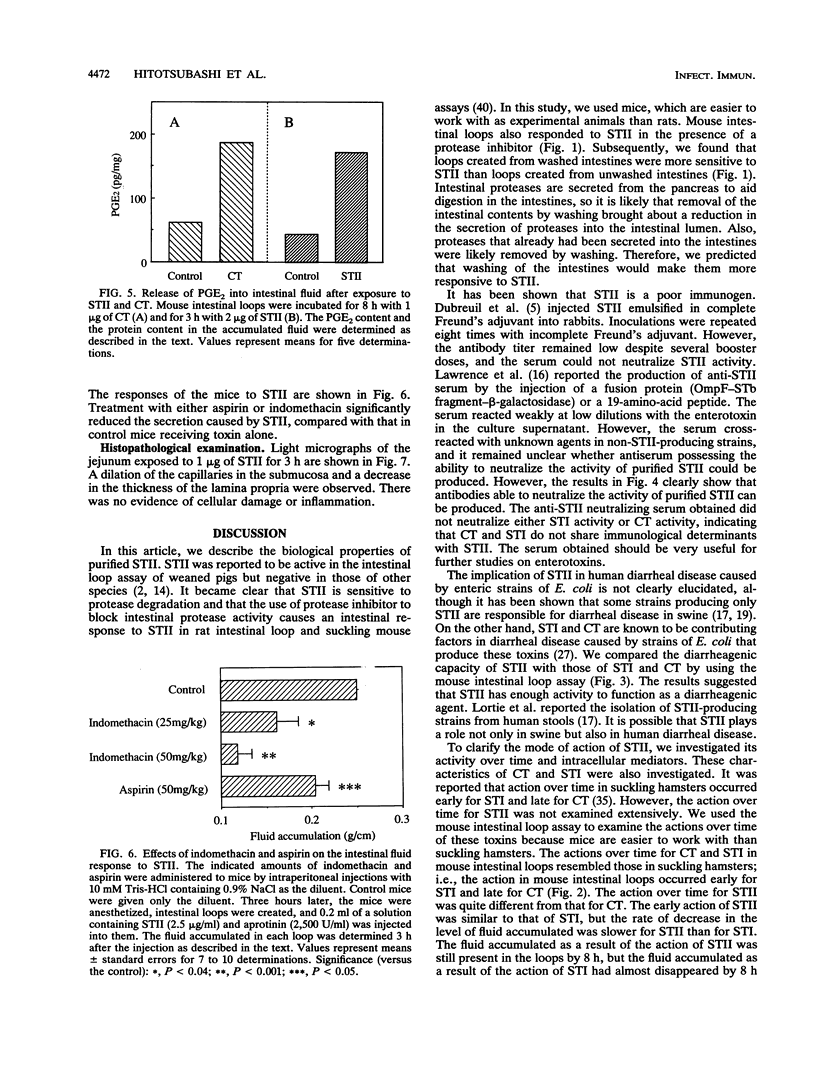
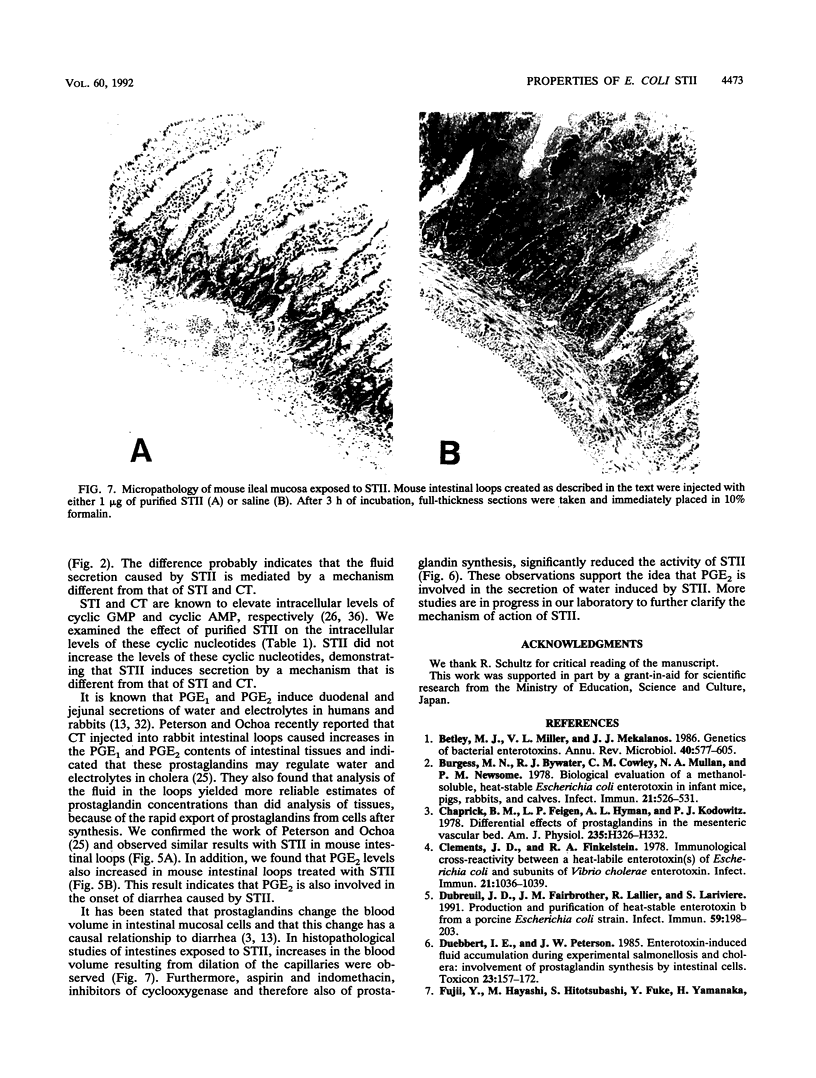
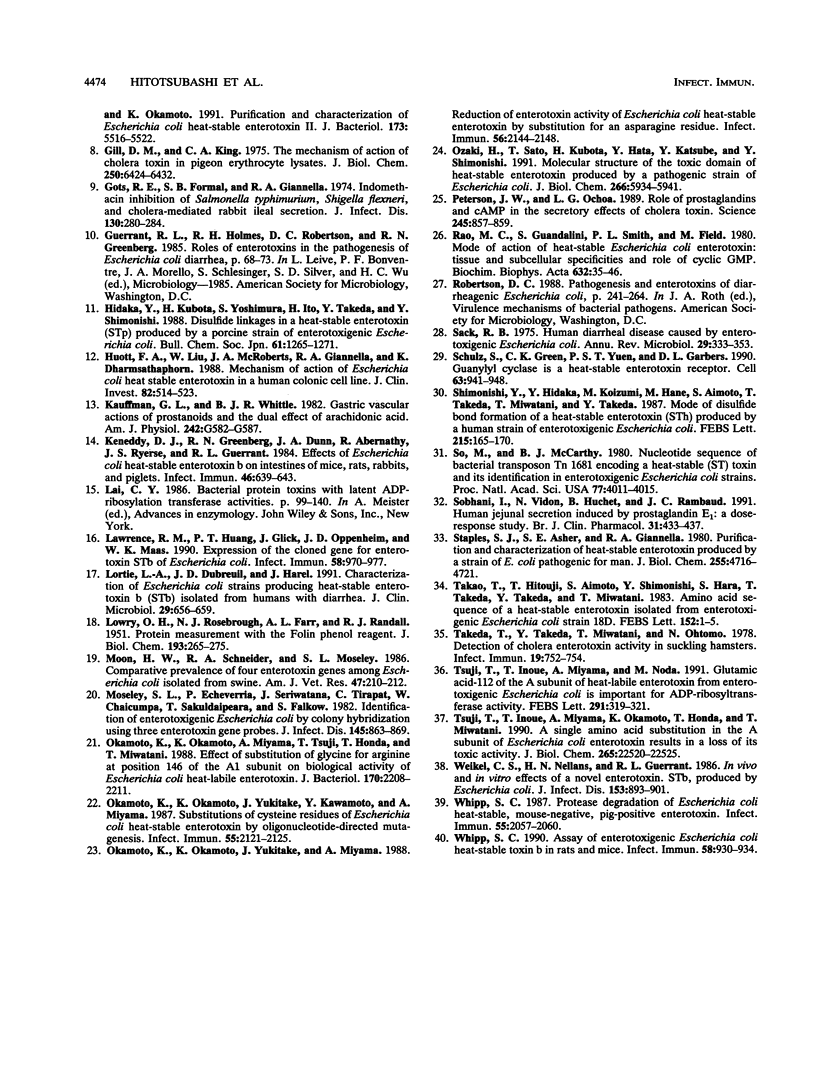
Images in this article
Selected References
These references are in PubMed. This may not be the complete list of references from this article.
- Betley M. J., Miller V. L., Mekalanos J. J. Genetics of bacterial enterotoxins. Annu Rev Microbiol. 1986;40:577–605. doi: 10.1146/annurev.mi.40.100186.003045. [DOI] [PubMed] [Google Scholar]
- Burgess M. N., Bywater R. J., Cowley C. M., Mullan N. A., Newsome P. M. Biological evaluation of a methanol-soluble, heat-stable Escherichia coli enterotoxin in infant mice, pigs, rabbits, and calves. Infect Immun. 1978 Aug;21(2):526–531. doi: 10.1128/iai.21.2.526-531.1978. [DOI] [PMC free article] [PubMed] [Google Scholar]
- Chapnick B. M., Feigen L. P., Hyman A. L., Kadowitz P. J. Differential effects of prostaglandins in the mesenteric vascular bed. Am J Physiol. 1978 Sep;235(3):H326–H332. doi: 10.1152/ajpheart.1978.235.3.H326. [DOI] [PubMed] [Google Scholar]
- Clements J. D., Finkelstein R. A. Immunological cross-reactivity between a heat-labile enterotoxin(s) of Escherichia coli and subunits of Vibrio cholerae enterotoxin. Infect Immun. 1978 Sep;21(3):1036–1039. doi: 10.1128/iai.21.3.1036-1039.1978. [DOI] [PMC free article] [PubMed] [Google Scholar]
- Dubreuil J. D., Fairbrother J. M., Lallier R., Larivière S. Production and purification of heat-stable enterotoxin b from a porcine Escherichia coli strain. Infect Immun. 1991 Jan;59(1):198–203. doi: 10.1128/iai.59.1.198-203.1991. [DOI] [PMC free article] [PubMed] [Google Scholar]
- Duebbert I. E., Peterson J. W. Enterotoxin-induced fluid accumulation during experimental salmonellosis and cholera: involvement of prostaglandin synthesis by intestinal cells. Toxicon. 1985;23(1):157–172. doi: 10.1016/0041-0101(85)90118-7. [DOI] [PubMed] [Google Scholar]
- Fujii Y., Hayashi M., Hitotsubashi S., Fuke Y., Yamanaka H., Okamoto K. Purification and characterization of Escherichia coli heat-stable enterotoxin II. J Bacteriol. 1991 Sep;173(17):5516–5522. doi: 10.1128/jb.173.17.5516-5522.1991. [DOI] [PMC free article] [PubMed] [Google Scholar]
- Gill D. M., King C. A. The mechanism of action of cholera toxin in pigeon erythrocyte lysates. J Biol Chem. 1975 Aug 25;250(16):6424–6432. [PubMed] [Google Scholar]
- Gots R. E., Formal S. B., Giannella R. A. Indomethacin inhibition of Salmonella typhimurium, Shigella flexneri, and cholera-mediated rabbit ileal secretion. J Infect Dis. 1974 Sep;130(3):280–284. doi: 10.1093/infdis/130.3.280. [DOI] [PubMed] [Google Scholar]
- Huott P. A., Liu W., McRoberts J. A., Giannella R. A., Dharmsathaphorn K. Mechanism of action of Escherichia coli heat stable enterotoxin in a human colonic cell line. J Clin Invest. 1988 Aug;82(2):514–523. doi: 10.1172/JCI113626. [DOI] [PMC free article] [PubMed] [Google Scholar]
- Kauffman G. L., Jr, Whittle B. J. Gastric vascular actions of prostanoids and the dual effect of arachidonic acid. Am J Physiol. 1982 Jun;242(6):G582–G587. doi: 10.1152/ajpgi.1982.242.6.G582. [DOI] [PubMed] [Google Scholar]
- Kennedy D. J., Greenberg R. N., Dunn J. A., Abernathy R., Ryerse J. S., Guerrant R. L. Effects of Escherichia coli heat-stable enterotoxin STb on intestines of mice, rats, rabbits, and piglets. Infect Immun. 1984 Dec;46(3):639–643. doi: 10.1128/iai.46.3.639-643.1984. [DOI] [PMC free article] [PubMed] [Google Scholar]
- LOWRY O. H., ROSEBROUGH N. J., FARR A. L., RANDALL R. J. Protein measurement with the Folin phenol reagent. J Biol Chem. 1951 Nov;193(1):265–275. [PubMed] [Google Scholar]
- Lai C. Y. Bacterial protein toxins with latent ADP-ribosyl transferases activities. Adv Enzymol Relat Areas Mol Biol. 1986;58:99–140. doi: 10.1002/9780470123041.ch3. [DOI] [PubMed] [Google Scholar]
- Lawrence R. M., Huang P. T., Glick J., Oppenheim J. D., Maas W. K. Expression of the cloned gene for enterotoxin STb of Escherichia coli. Infect Immun. 1990 Apr;58(4):970–977. doi: 10.1128/iai.58.4.970-977.1990. [DOI] [PMC free article] [PubMed] [Google Scholar]
- Lortie L. A., Dubreuil J. D., Harel J. Characterization of Escherichia coli strains producing heat-stable enterotoxin b (STb) isolated from humans with diarrhea. J Clin Microbiol. 1991 Mar;29(3):656–659. doi: 10.1128/jcm.29.3.656-659.1991. [DOI] [PMC free article] [PubMed] [Google Scholar]
- Moon H. W., Schneider R. A., Moseley S. L. Comparative prevalence of four enterotoxin genes among Escherichia coli isolated from swine. Am J Vet Res. 1986 Feb;47(2):210–212. [PubMed] [Google Scholar]
- Moseley S. L., Echeverria P., Seriwatana J., Tirapat C., Chaicumpa W., Sakuldaipeara T., Falkow S. Identification of enterotoxigenic Escherichia coli by colony hybridization using three enterotoxin gene probes. J Infect Dis. 1982 Jun;145(6):863–869. doi: 10.1093/infdis/145.6.863. [DOI] [PubMed] [Google Scholar]
- Okamoto K., Okamoto K., Miyama A., Tsuji T., Honda T., Miwatani T. Effect of substitution of glycine for arginine at position 146 of the A1 subunit on biological activity of Escherichia coli heat-labile enterotoxin. J Bacteriol. 1988 May;170(5):2208–2211. doi: 10.1128/jb.170.5.2208-2211.1988. [DOI] [PMC free article] [PubMed] [Google Scholar]
- Okamoto K., Okamoto K., Yukitake J., Kawamoto Y., Miyama A. Substitutions of cysteine residues of Escherichia coli heat-stable enterotoxin by oligonucleotide-directed mutagenesis. Infect Immun. 1987 Sep;55(9):2121–2125. doi: 10.1128/iai.55.9.2121-2125.1987. [DOI] [PMC free article] [PubMed] [Google Scholar]
- Okamoto K., Okamoto K., Yukitake J., Miyama A. Reduction of enterotoxic activity of Escherichia coli heat-stable enterotoxin by substitution for an asparagine residue. Infect Immun. 1988 Aug;56(8):2144–2148. doi: 10.1128/iai.56.8.2144-2148.1988. [DOI] [PMC free article] [PubMed] [Google Scholar]
- Ozaki H., Sato T., Kubota H., Hata Y., Katsube Y., Shimonishi Y. Molecular structure of the toxin domain of heat-stable enterotoxin produced by a pathogenic strain of Escherichia coli. A putative binding site for a binding protein on rat intestinal epithelial cell membranes. J Biol Chem. 1991 Mar 25;266(9):5934–5941. [PubMed] [Google Scholar]
- Peterson J. W., Ochoa L. G. Role of prostaglandins and cAMP in the secretory effects of cholera toxin. Science. 1989 Aug 25;245(4920):857–859. doi: 10.1126/science.2549637. [DOI] [PubMed] [Google Scholar]
- Sack R. B. Human diarrheal disease caused by enterotoxigenic Escherichia coli. Annu Rev Microbiol. 1975;29:333–353. doi: 10.1146/annurev.mi.29.100175.002001. [DOI] [PubMed] [Google Scholar]
- Schulz S., Green C. K., Yuen P. S., Garbers D. L. Guanylyl cyclase is a heat-stable enterotoxin receptor. Cell. 1990 Nov 30;63(5):941–948. doi: 10.1016/0092-8674(90)90497-3. [DOI] [PubMed] [Google Scholar]
- Shimonishi Y., Hidaka Y., Koizumi M., Hane M., Aimoto S., Takeda T., Miwatani T., Takeda Y. Mode of disulfide bond formation of a heat-stable enterotoxin (STh) produced by a human strain of enterotoxigenic Escherichia coli. FEBS Lett. 1987 May 4;215(1):165–170. doi: 10.1016/0014-5793(87)80134-5. [DOI] [PubMed] [Google Scholar]
- So M., McCarthy B. J. Nucleotide sequence of the bacterial transposon Tn1681 encoding a heat-stable (ST) toxin and its identification in enterotoxigenic Escherichia coli strains. Proc Natl Acad Sci U S A. 1980 Jul;77(7):4011–4015. doi: 10.1073/pnas.77.7.4011. [DOI] [PMC free article] [PubMed] [Google Scholar]
- Sobhani I., Vidon N., Huchet B., Rambaud J. C. Human jejunal secretion induced by prostaglandin E1: a dose-response study. Br J Clin Pharmacol. 1991 Apr;31(4):433–437. doi: 10.1111/j.1365-2125.1991.tb05559.x. [DOI] [PMC free article] [PubMed] [Google Scholar]
- Staples S. J., Asher S. E., Giannella R. A. Purification and characterization of heat-stable enterotoxin produced by a strain of E. coli pathogenic for man. J Biol Chem. 1980 May 25;255(10):4716–4721. [PubMed] [Google Scholar]
- Takao T., Hitouji T., Aimoto S., Shimonishi Y., Hara S., Takeda T., Takeda Y., Miwatani T. Amino acid sequence of a heat-stable enterotoxin isolated from enterotoxigenic Escherichia coli strain 18D. FEBS Lett. 1983 Feb 7;152(1):1–5. doi: 10.1016/0014-5793(83)80469-4. [DOI] [PubMed] [Google Scholar]
- Takeda T., Takeda Y., Miwatani T., Ohtomo N. Detection of cholera enterotoxin activity in suckling hamsters. Infect Immun. 1978 Feb;19(2):752–754. doi: 10.1128/iai.19.2.752-754.1978. [DOI] [PMC free article] [PubMed] [Google Scholar]
- Tsuji T., Inoue T., Miyama A., Noda M. Glutamic acid-112 of the A subunit of heat-labile enterotoxin from enterotoxigenic Escherichia coli is important for ADP-ribosyltransferase activity. FEBS Lett. 1991 Oct 21;291(2):319–321. doi: 10.1016/0014-5793(91)81311-u. [DOI] [PubMed] [Google Scholar]
- Tsuji T., Inoue T., Miyama A., Okamoto K., Honda T., Miwatani T. A single amino acid substitution in the A subunit of Escherichia coli enterotoxin results in a loss of its toxic activity. J Biol Chem. 1990 Dec 25;265(36):22520–22525. [PubMed] [Google Scholar]
- Weikel C. S., Nellans H. N., Guerrant R. L. In vivo and in vitro effects of a novel enterotoxin, STb, produced by Escherichia coli. J Infect Dis. 1986 May;153(5):893–901. doi: 10.1093/infdis/153.5.893. [DOI] [PubMed] [Google Scholar]
- Whipp S. C. Assay for enterotoxigenic Escherichia coli heat-stable toxin b in rats and mice. Infect Immun. 1990 Apr;58(4):930–934. doi: 10.1128/iai.58.4.930-934.1990. [DOI] [PMC free article] [PubMed] [Google Scholar]
- Whipp S. C. Protease degradation of Escherichia coli heat-stable, mouse-negative, pig-positive enterotoxin. Infect Immun. 1987 Sep;55(9):2057–2060. doi: 10.1128/iai.55.9.2057-2060.1987. [DOI] [PMC free article] [PubMed] [Google Scholar]



